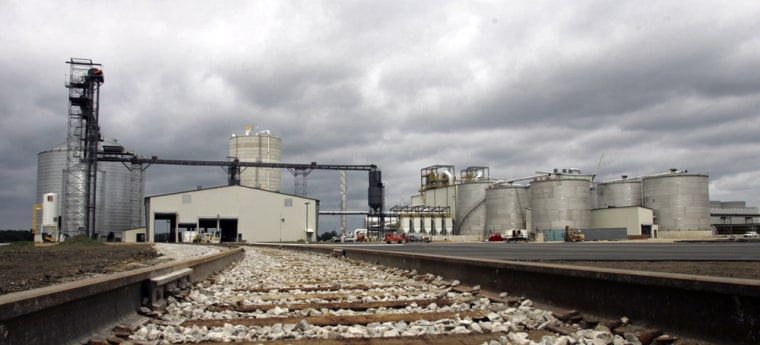It may be one of the biggest green gambles of the century: a national goal of converting wood, grass, corn stalks and garbage into 16 billion gallons of cellulosic biofuels annually by 2022.
No commercial-scale refineries exist, researchers have yet to agree on the best technology for fuel conversion and there is no distribution network to handle fuel once it is made.
Add it all up and the country's not even close to meeting the EPA's renewable fuel standards a mere 14 years from now.
"The United States could not move that much ethanol today if it had to," said biofuel consultant Bill Caesar, a principal with McKinsey & Co. "There are a lot of other pieces of the puzzle which need to fall in place over time before we hit these very big numbers."
The government has ordered that 36 billion gallons of biofuel be blended into the fuel supply by 2022. Of that, 16 billion must be cellulosic ethanol. No more than 15 billion can be corn ethanol, with the rest coming from other biofuel sources, such as the residue left from sugar production.
Increased use of renewable fuel is one of the major roads to the country's new energy goals, which include reducing reliance on foreign oil, shrinking greenhouse gas emissions and keeping basic transportation affordable.
An estimated 200-plus large-scale facilities are needed to meet the Environmental Protection Agency's standards — each capable of producing about 100 million gallons a year.
A few dozen biofuel projects are on the drawing table across the country, almost all of them cellulosic. Those include 13 biofuel plants funded by the Department of Energy, and only four are commercial scale.
BlueFire Ethanol, based in Irvine, Calif., produces fuel from lawn trimmings and other landfill waste products. Arnold Klann, co-founder and chief executive officer, says he could open dozens of commercial-scale plants from now until 2022 and produce only 5 billion gallons a year. His first plant, the recipient of $40 million in federal startup money, won't open until late next year.
Pros, cons of cellulosic
Ethanol advocates all agree that cellulosic ethanol is the next step for the biofuel industry for a variety of reasons.
Cellulosic-based fuel isn't made from food, such as corn, dodging the food vs. fuel debate. Corn, which was selling at around $4.10 a bushel this week, has more than doubled in price in the past two years.
Cellulosic ethanol also results in fewer greenhouse gas emissions during production. And there's a lot more of it, from wood chips to grass to garbage. It can be grown in places where corn can't, and doesn't require the same maintenance of a food crop.
Those are all selling points but don't get the nation any closer to 16 billion gallons of fuel.
Shipping the raw material is complicated because it generally is lighter than corn, so more is needed to make a shipment financially feasible. Some of the material, such as switchgrass, deteriorates more quickly.
It's still a big gamble for investors, even with a potentially massive payoff.
"If oil stays in the $140 range, you can probably make a celluolose plant pay, but are you willing to bet $400 million it will stay there?" said Wally Tyner, a Purdue University agricultural economist.
The government says the federal standard of 36 billion gallons is reachable but agrees it is up to federal officials to assure investors that the country's financial commitment is strong and lasting.
"We've stimulated the excitement — government's got to sustain that investment," said Alexander Karsner, the Energy Department assistant secretary for energy efficiency and renewable energy.
EPA spokeswoman Cathy Milbourn says the ethanol market will expand as mandated biofuel production increases.
Dual-purpose plant proposed
Sioux Falls, S.D.-based Poet LLC, the nation's top ethanol producer, says one of the solutions to meeting the cellulosic standard is building plants capable of producing both kinds of ethanol.
One of those plants is to open this month on a 90-acre site in rural Marion County in central Ohio.
The plant will process about 30,000 bushels of corn an hour, producing about 65 million gallons of corn-based ethanol annually.
However, the biorefinery can add cellulosic material to the mix, upping the output. Much of that could be parts of the corn, such as stalks and cobs, that now go unused in the ethanol process.
"We can use the same farmers, the same fields, the same infrastructure to get cellulose to the plants," said Mark Stowers, Poet's vice president for research and development. "We don't have to reinvent the wheel."
Advocates say the odds are on cellulosic ethanol's side for a variety of reasons. The need to reduce dependence on foreign oil has never appeared greater. Petroleum supplies will continue to be tight as the appetite for oil in China and India and other emerging countries grows. And belief is growing in the "peak oil" theory, that the outer limits of the global petroleum supply has been reached.
"We've never had the same kind of focus on energy that we have today in the history of the U.S.," said Melissa Stark, leader of a team of Accenture analysts looking at the future of biofuels.
"All of a sudden, cracking climate change is as important as putting a man on the moon," she said.
